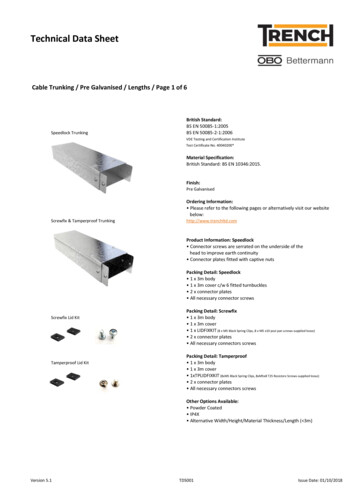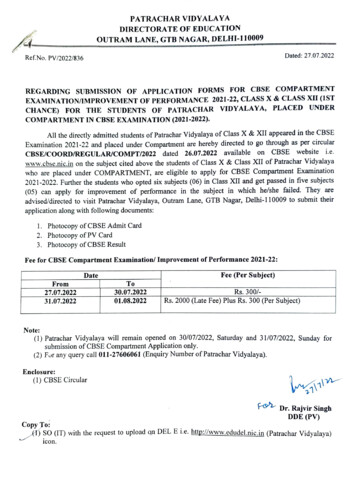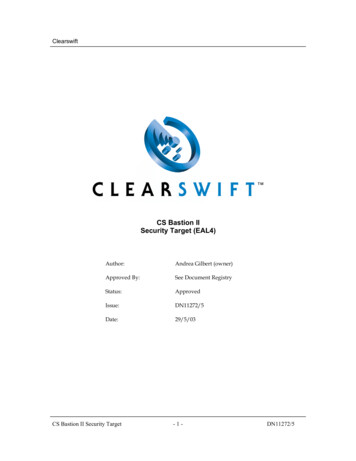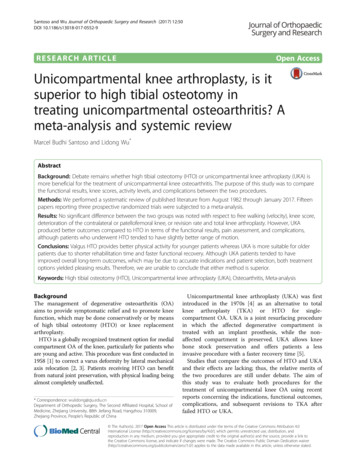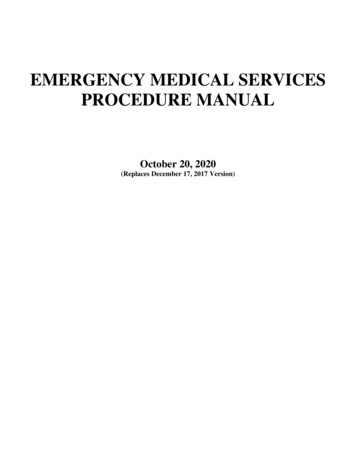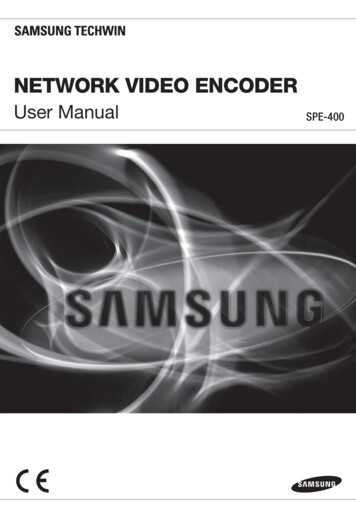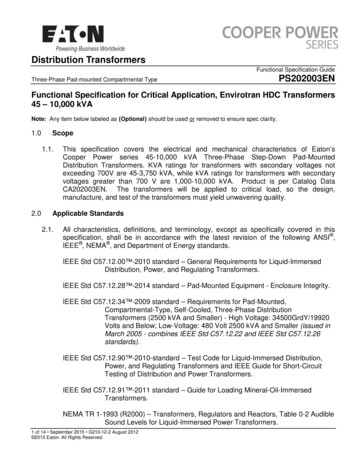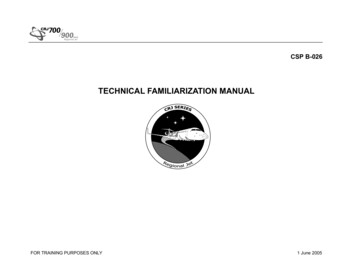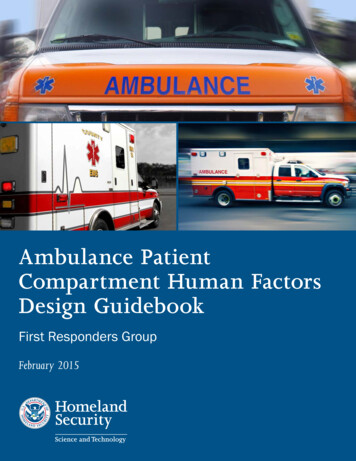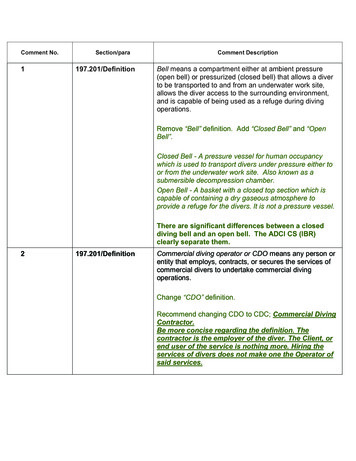
Transcription
Comment No.1Section/para197.201/DefinitionComment DescriptionBell means a compartment either at ambient pressure(open bell) or pressurized (closed bell) that allows a diverto be transported to and from an underwater work site,allows the diver access to the surrounding environment,and is capable of being used as a refuge during divingoperations.Remove “Bell” definition. Add “Closed Bell” and “OpenBell”.Closed Bell - A pressure vessel for human occupancywhich is used to transport divers under pressure either toor from the underwater work site. Also known as asubmersible decompression chamber.Open Bell - A basket with a closed top section which iscapable of containing a dry gaseous atmosphere toprovide a refuge for the divers. It is not a pressure vessel.There are significant differences between a closeddiving bell and an open bell. The ADCI CS (IBR)clearly separate them.2197.201/DefinitionCommercial diving operator or CDO means any person orentity that employs, contracts, or secures the services ofcommercial divers to undertake commercial divingoperations.Change “CDO” definition.Recommend changing CDO to CDC; Commercial DivingContractor.Be more concise regarding the definition. Thecontractor is the employer of the diver. The Client, orend user of the service is nothing more. Hiring theservices of divers does not make one the Operator ofsaid services.
Comment No.3Section/para197.201/DefinitionComment DescriptionAdd “Client” definition.Recommend staying away from the term “Operator” asthe client is not always an oil or gas Operator.Client – A company, or entity, that enters in an agreementto utilize the professional services of a Commercial DivingContractor.4197.201/DefinitionDive means work performed by a diver or the activity thatis taken in support of that work and that is the subject of adive plan.Change “dive” definition.Recommend changing to read; “Dive” means any person,or persons, exposed to hyperbaric conditions performingwork or tasks that are the subject of a dive plan.”The way that “dive” is proposed to be definedencompasses anyone operating equipment in supportof the dive.5197.201/DefinitionAdd “Management of Change (MOC)” definition.Management of Change (MOC) – A process thataddresses changes to organization, personnel, systems,procedures, equipment products, materials or substances,that are not “replacement in kind”.The MOC process ensures that the impacts of changesthat affect the health and safety of personnel, or threatensthe environment are properly recognized, reviewed,approved, communicated and documented. See 30 CFRChapter II Subchapter B Part 250 Subpart S 250.1912
Comment No.6Section/para197.201/DefinitionComment DescriptionMixed Gas Dive.Mixed-gas dive means a dive mode in which the diver inthe water is supplied with a breathing gas other than air.This needs to be refined to be specific to HEO2 diving,not enriched air such as Nitrox.Definition of Mixed gas diving states “other than air”this will unintentionally make many “air” dives fallunder the regulation of a mixed gas dive. “Air” divesroutinely use gases other than air, 50/50decompression mixes in the water, enriched air and/ornitrox. Mixed gas in the GOM industry generally refersto HeO2 diving and the definition should reflect this.7197.201/DefinitionAdd “Hyperbaric Rescue Unit (HRU)” definition.Hyperbaric Rescue Unit (HRU) - A unit whereby Diversunder pressure can be safely evacuated from a ship orfloating structure to a place where decompression can becarried out. This is used to describe a HRC or SPHL.8197.201/DefinitionAdd “Self-Propelled Hyperbaric Lifeboat (SPHL)” definition.Self-Propelled Hyperbaric Lifeboat (SPHL) - The SPHL is aPVHO fitted in a conventional lifeboat hull, making it ahyperbaric rescue unit capable of maneuvering under itsown power with the ability to accommodate a supportcrew. The SPHL must have the ability to sustain themaximum capacity of divers for 72 hours.9197.201/DefinitionAdd “Hyperbaric Rescue Chamber (HRC)” definition.Hyperbaric Rescue Chamber (HRC) - The HRC is atowable hyperbaric rescue unit. It is a PVHO that is nothoused in a conventional life boat and has no capability toaccommodate a support crew. The HRC must have theability to sustain the maximum capacity of divers for 72hours.
Comment No.10Section/para197.201/DefinitionComment DescriptionAdd “Hyperbaric Rescue Facility (HRF)” definition.Hyperbaric Rescue Facility (HRF) - The HRF is a facilitycapable of accepting an HRU where the divers can betransferred under pressure to receive medical attentionand safely complete decompression.11197.201/DefinitionAdd “Life Support Package (LSP)” definition.Life Support Package (LSP) - The LSP is a self-containedpackage of supplies and equipment kept in apredetermined location dedicated to support the HRU inthe event of a hyperbaric evacuation. The LSP must bemobilized quickly to provide the necessary support to theHRU.12197.201/DefinitionAdd “Hyperbaric Evacuation Plan (HEP)” definition.Hyperbaric Evacuation Plan (HEP) - The comprehensiveplanning document that describes the methods, theprocesses and the procedures used to evacuate saturationdivers away from a stricken diving system to a safe refugewhere decompression can be carried out.13197.201/DefinitionAdd “Hyperbaric Evacuation System (HES)” definition.Hyperbaric Evacuation System (HES) – A system used forthe purpose of evacuating divers under hyperbaricconditions. The system is made up of various parts whichmay include the Hyperbaric Evacuation Plan, theHyperbaric Rescue Unit, the Hyperbaric Rescue Facility,the Safe Haven and anything else that is used in theplanned hyperbaric evacuation.
Comment No.14Section/para197.201/DefinitionComment DescriptionAdd “Safe Haven” definition.Safe Haven - It should be understood that it may notalways be possible, or practical, for an HRU to travel to aland based HRF. Contingency plans should include analternate site. This could be a saturation Diving SupportVessel, a platform, a vessel with sufficient crane capacityor another clearly identified option. This site will provide asafe haven to carry out the decompression and providelogistical support.15197.201/DefinitionRisk management measure means the assignment ofadditional or different personnel, equipment, or otherresources, the implementation of effective policies orpractices, or any other measure appropriate for themanagement or reduction of risks that may be anticipatedduring a dive.Recommend changing “Risk Management Measure”definition to “Risk Assessment” to align with industryterminology.16197.201/DefinitionAdd “Job Safety Analysis (JSA)” definition.Job Safety Analysis (JSA) - a technique used to identifyrisks to personnel associated with their job activities. TheJSAs are also used to determine the appropriate mitigationmeasures needed to reduce job risks to personnel. TheJSA must include all personnel involved with the jobactivity. See 30 CFR Chapter II Subchapter B Part 250Subpart S 250.191117197.201/DefinitionAdd Manifold OperatorManifold Operator - Individual, such as an LST, divingsupervisor or mixed-gas diver, who is designated toperform the duties of gas distribution on a surface-suppliedmixed gas (HeO₂) diving operation, who is experiencedand trained in the operation of the manifold, and whose
Comment No.Section/paraComment Descriptionprimary responsibility is to operate the manifold.For HEO2 diving the manifold operator should bedesignated by the supervisor.18197.201/DefinitionSerious marine incident has the meaning defined in 46CFR 4.03–2. See 46 CFR 4.03-2Definition Serious Marine incident - the definition isclear but incident and accident are usedinterchangeably throughout the document andaccident is undefined. “Accident” in the documentshould be changed to “incident”.19197.201/DefinitionAdd “Tabletop Exercise” definition.A tabletop exercise is an exercise which is designed to testthe theoretical ability of a group to respond to anemergency situation. Tabletop exercises can be used toidentify gaps in a plan and they promote cooperativethinking among teams.20197.202/IBR(d) American Society of Mechanical Engineers (ASME)(1) ASME PVHO-1(2) Recommend adding ASME PVHO-2(3) ASME B31.1(4) ASME National Board Inspection CodeReworded to stay away from dates or date specificrevisions21197.202/IBR(b) Association of Diving ContractorsInternational, 5206 Cypress CreekParkway, Suite 202, Houston, TX 77069,http://adc-int.org/.(1) International Consensus Standardsfor Commercial Diving and UnderwaterOperations, 6th Edition, 2010 (‘‘ADCIStandards’’)
Comment No.Section/paraComment DescriptionRecommend changing to read “International ConsensusStandards for Commercial Diving and UnderwaterOperations, Most Current Edition (‘‘ADCIStandards’’)22197.202/IBR(e) American National Standards Institute (ANSI), 25 West43rd Street, Fourth Floor, New York, NY 10036,http://www.ansi.org.(1) ANSI/ISO 15618–1:2001, Qualification testing ofwelders for underwater welding—Part 1: Diver welders forhyperbaric wet welding (‘‘ANSI/ISO 15618’’)Recommend removal of ANSI/ISO 15618-1:2001 and referto American Welding Society (AWS) D3.6 M:2010 or mostcurrent edition23197.203/Equivalents(a) The Commandant may accept substitutes forequipment, materials, apparatus, arrangements,procedures, or tests required in this subpart if thesubstitute provides an equivalent level of safety.(b) The person or entity receiving the equivalencydetermination must keep a copy of that determination andmake it available to any of the person’s or entity’semployees, an approved third party organization, or CoastGuard personnel upon request.What is the process for variance or substitutionrequests?24197.209/Third partyAuditsThis section would mean creating an auditing industrythat does not currently exist.Making 3rd party inspections mandatory leaves thediving contractor responsible for yet undeterminedand possibly exorbitant costs and delays from 3rdparty auditing companies that will be created and havea government mandate behind them.
Comment No.25Section/para197.211/ExternalAuditsComment DescriptionEach CDO, and vessel or facility owner that permits acommercial diving operation to take place on board, musthave an external compliance audit conducted by anapproved TPO at least twice in each 5 year period.We need clarification on the external audits.Also need to understand if this is only USCGinspected vessels, or any facility or vessel withinUSCG jurisdiction?Will a platform or rig require this external audit? How doesthis apply to MODU’s that permit diving operations fromtheir decks 1-2 times for every 5 years, or on an “asneeded” or short notice basis?What about CDO’s that “spot hire” USCG approvedvessels on short notice for their operations as needed?Most diving contractors do not own their own vessels, andmust contract USCG approved vessels as needed.Will all vessels in the GoM be required to undergo theseadditional audits in the event that they are hired?26197.212(a)/Pre-auditnotification(a) Each commercial diving operator (CDO) or vessel orfacility owner that permits a commercial diving operation totake place on board must notify the cognizant Officer inCharge, Marine Inspection (OCMI) at least 5 working daysbefore the start of any external audit conducted under 46CFR 197.211.Flexibility should be added to this paragraph to allowfor short weather windows, scope changes, shortnotice jobs, and urgent tasks.This happens FREQUENTLY.This regulation could negate working during seasonsof the year when plans are made on less than a 5 dayweather forecast and subsequently severely impactthe diving contractors.Do other industries under USCG jurisdiction have
Comment No.Section/paraComment Descriptionsuch restrictions?27197.213/AuditReporting(d) CDO’s must retain copies of TPO audit reports andmake them available for examination by the USCG uponrequest.No timeframe is mentioned for retention of documents.Recommend changing to “CDO’s must retain copies ofTPO audit reports for a minimum of XXX and make themavailable for examination by the USCG upon request.”It would be difficult to keep copies indefinitely.28197.220/CDO (e)(e) The name of the dive supervisor for each commercialdiving operation is provided to the person in charge (PIC)of the vessel or facility before beginning the operation;Recommend changing to:“The name of the diving supervisor(s) for each commercialdiving operation shall be—(a) Designated in writing; and(b) Given to the person-in-charge prior to thecommencement of any commercial diving operation.This is the language that exists in the current 46 CFR197.210 and should remain in place. The DesignatedPerson in Charge of Diving Operations (DPIC) hasbecome the norm.29197.220/CDOTable 197.220(f) – Drill requirementsRecommend removing and replace with:197.220 Drills rev1.docx
Comment No.3031Section/para197.220/(i) CDO197.220/(k) CDOComment DescriptionTable 197.220(i)This is excellent, just recommend adding applicable:All applicable dive team members participate in a diveplanning meeting before each dive, that the meetingensures that a dive plan is prepared specific to each diveidentifying the person in charge of the vessel or facility, thedive supervisor, and the roles and responsibilities of alldive team members, the anticipated conditions and risksthat could affect the dive and risk management measuresimplemented to reduce risks; and that each dive teammember reviews and signs the plan to documentparticipation in the meeting and agreement with the planThe addition of the word “applicable” will allow offshift dive team members to rest during 24 houroperations.(k) The local Officer in Charge, Marine Inspection isprovided with a dive notice containing the contentsspecified in table 197.220(k) of this section at least 24hours before any commercial diving operation begins.Contact information . For the CDO, dive supervisor, and PIC: Name,telephone or e-mail, or other contact information.Date and time . Scheduled start and end date and time.Dive location . Geographic position (latitude and longitude).Diving system safety certificate . Certificate number, date of expiration, flagadministration, and issuing authority if other than the administration. (if applicable)Mode . Mode of diving to be used.Support platform . Name of each vessel or facility providing divesupport.Work . Description of work to be performed includingmaximum depth and exposure time.MOST diving systems do not, and will not have adiving system safety certificate.Certifying current systems to “Class” and/or buyingsystems that are pre-certified are extremely costprohibitive to most contractors.How would all existing (yet compliant and safe) divingequipment owners meet this requirement?This could be financially ruinous to a majority ofdiving contractors in the GoM and would leave thedive contractor at the mercy of a 3rd party foravailability and cost.Recommend that all diving systems and equipment
Comment No.Section/paraComment Descriptionare COMPLIANT to ADCI, IMCA, or equipmentguidelines.32197.221/PIC(c) The PIC must –(1) Participate in the dive plan meeting and sign the diveplan.Recommend changing to:(1) Participate, or have a designated alternate in writingparticipate, in the dive plan meeting and sign the dive plan.Reason: It is not reasonable to have the PIC (vesselmaster) attend every dive plan meeting around the clock.Note: Most diving contractors do not own vessels, meaningthe PIC could be the Master of a vessel contracted by theCDO, and have little understanding of how divingoperations are conducted.33197.222/DiveSupervisors(l) Keep a record in the dive log noting where and whentesting occurred for each of the following, along with thetest results(1) Medical kit check (monthly)(2) Air compressor test;(3) Breathing mixture check;(4) Breathing supply system check;(5) Cleaning of diving equipment foroxygen service, including whichequipment was cleaned, the generalcleaning procedure, and the names ofpersons involved;(6) Breathing supply hose and systemtests;(7) Breathing gas supply systeminspection;(8) Depth gauge and timekeepingdevice test;(9) Pressure vessel for humanoccupancy test and inspection;(10) Diving equipment inspection;(11) Pressure piping test andinspection; and
Comment No.Section/paraComment Description(12) Volume tank and cylinder testand inspection;see next pageRecommend changing to:(l) Diving Contractor is to provide the diving supervisor witha certification book that identifies where and when testingoccurred for each of the following, along with the testresults. Diving Contractor is to maintain records for aminimum of five years.34197.223/OperationsManualThe Diving Contractor is responsible for ensuring theequipment is properly maintained. The divesupervisor should be given this information so it canbe reviewed and challenged as needed. The divingcontractor must have a competent person sign off thetesting.(a) Each dive supervisor must provide the operationsmanual to the person in charge (PIC) prior tocommencement of any diving operation and make itavailable at the dive location to all members of the diveteam.Note: Most diving contractors do not own their ownvessels, meaning the PIC could be the Master of a vesselcontracted by the CDO, and as a non-diving 3rd party, thePIC may have little understanding of how diving operationsare conducted.Although the operations manual should be available to allat the dive location, providing one to a 3rd party PIC maynot be practical.197.223/Operations(b) The dive supervisor must modify the operations manual
Comment No.Section/paraManual (cont.)Comment Descriptionto reflect any change in the configuration or operation ofthe vessel or facility or in the specific diving operation asplanned.Recommend changing to:(b) A management of change process will be followed forany changes in the configuration or operation of the vesselor facility or in the specific diving operation as planned.35197.224/ Operationalduties in the event ofmarine casualty orserious marineincident.The Dive Supervisor will never change the operationsmanual. A company typically has (1) primaryOperations Manual.Even if this were meant to say “dive plan, projectexecution plan or a project procedure”, the MOCprocess should still be required to ensure changes areimplemented correctly.(3) Arrange for a timely post-casualty audit to beconducted in accordance with 46 CFR 197.211;CFR-2008-title46-vol This requires a 3rd party audit prior to returning to workfollowing a marine casualty or serious marine incident.A serious marine incident is defined as: “An injury to acrewmember, passenger, or other person which requiresprofessional medical treatment beyond first aid and, in thecase of a person employed aboard a vessel in commercialservice, which renders the individual unfit to performroutine vessel duties.”197.224/ Operationalduties in the event ofUnder this, a diver receiving a lionfish sting that becomesinfected, a treatable DCS case, or the damage of anexpensive piece of equipment will trigger the shut-down ofthe job, and the sequester of vessel and equipment until a3rd party auditor can be sourced and becomes available.This could be financially ruinous and would leave the divecontractor at the mercy of a 3rd party for availability andcost.The current reporting and investigation requirements andthe proven cooperation of the industry does not lead me to
Comment No.Section/paramarine casualty orserious marineincident.Comment Descriptionbelieve that this new regulation would prove beneficial,and it could actually be harmful.Currently, in the cases of truly serious diving incidents,contractors work with the USCG and at its direction untilreleased.36197.243/Divers andDive Tenders(c) In lieu of the requirements in section 3.7.3(a) and (b) ofthe ADCI Standards (incorporated by reference, see 46CFR 197.202), a saturation diver must complete at least200 dives as an air or mixed-gas diver; and complete atleast 100 dives as a mixed-gas diver.This is in reference to saturation dive certification.Recommend removing the text “and complete at least 100dives as a mixed-gas diver” Reason: There is lessHEO2 surface diving today than in the past as theseprojects are being pushed to shallow saturation.37197.246/ Individualsconductingunderwater burning,welding, orexothermic cutting.Each individual conducting underwater burning, welding,or exothermic cutting must provide the commercial divingoperator and dive supervisor with documentation showingsuccessful completion of a course for underwater welding,burning, and cutting containing curriculum based onANSI/ACDE–01–2009 (incorporated by reference, see 46CFR 197.202) and successful completion of a written andpractical exam based on ANSI/ISO 15618 (incorporated byreference, see 46 CFR 197.202).ANSI/ISO 15618-1:2001, Qualification testing of welders forunderwater welding is antiquated and in the process of beingrewritten.AWS D36.B is a more up to date and a better publication forthe purpose cited.Reference ADCI CS 5.31 or current ADCI CS
Comment No.38Section/para197.246/ Individualsconductingunderwater burning,welding, orexothermic cutting.Comment DescriptionANSI/ISO 15618-1:2001, Qualification testing of welders forunderwater welding. This document is antiquated and in theprocess of being rewritten.AWS D36.B is a more up to date and a better publication forthe purpose cited.Reference ADCI CS 5.31 or current ADCI CS39197.252/Work HoursEach commercial dive operator and dive supervisor mustensure that each dive member is provided the opportunityto obtain at least 12 hours of rest within any 24-hourperiod, except in an emergency or drills that may berequired in accordance with 46 CFR 15.710(d).ADCI Rest Policy5-15.pdfRecommend changing to IBR ADCI Section 5.15 Minimum Rest Hour Policy4041197.261/Operationsconducted from adynamic positioningvessel.(3) Ensure that the onboard dive location is not locatedwithin 5 meters of a propulsion source.197.263/OperationsInvolving ScubaRecommend “Outside its use in Scientific andArchaeological diving, there are unlikely to be anycircumstances where surface supplied equipment cannotbe used, therefore scuba diving under USCG commercialdiving jurisdiction should be considered an unsafe workingpractice”.Recommend removing this part, as it adds no value andmay cause confusion.The ADCI section 8.3.9.1 states “Main umbilical must be20 feet shorter that the closest hazard”.The process for requesting to use scuba for Scientificand Archeological purposes would still need to bedefined, but there are no clear reasons why surfacesupplied can’t be used for all commercial purposesunder USCG jurisdiction.
Comment nt DescriptionCommercial diving operators must ensure that theprocedures identified in the U.S. Navy Diving Manual,Sixth Edition (incorporated by reference, see 46 CFR197.202) are followed when a diver’s decompression isrequired but has been omitted.Recommend changing to read: When a diver’sdecompression is required but has been omitted; thecommercial diving operator must ensure that there areprocedures in place and followed. The U.S. Navy DivingManual, Sixth Edition (incorporated by reference, see 46CFR 197.202) should be used as a minimum. Otherequivalent or more conservative treatment plans/tablesmay be used or the treatment orders of the company’sDiving Medical Officer may be followed.For instance, the diving contractor’s Diving MedicalOfficer, or hyperbaric physician, will normally directthe diver be treated above a Table 5, which is the USNavy Diving Manuals treatment requirement.43197.270/GeneralRequirementsRecommend adding NOSAC HES Focus Group language,or a modified version of it.Saturation ) A modular or packaged commercial diving unit placedaboard a vessel for use in a commercial diving operationmust have documentation indicating that the unit and itsinstallation have been reviewed and approved for itsintended use by a recognized classification society thatmeets the requirements of 46 CFR part 8, or by anotherorganization acceptable to the Office of Design andEngineering Standards, Commandant (CG ENG).Need to revise, or at least clarify, this language. If theUSCG is requiring classed systems, is it in reference tosaturation diving systems, air diving systems, or both?
Comment No.Section/paraComment DescriptionThe way the paragraph reads, it seems to call for theclassing of all diving systems (modular or packaged). Thiswould be unduly burdensome on the industry andfinancially unachievable (and ruinous) for many small tomedium diving companies and operators using smallmodular surface diving spreads, and would leave the divecontractor at the mercy of a 3rd party for availability andcost.By calling for class on surface diving spreads, theregulations are incorporating by reference hundreds ofrules and standards of the classing society’s, not applyingto just equipment but procedures, training, record keeping,etc.Recommend moving toward classing of the saturationdiving systems only, but ensure that surface divingspreads are compliant with ADCI, IMCA, etc.45197.270/GeneralRequirements(e) Where a hyperbaric lifeboat is provided as anemergency evacuation system it must—(1) Be used for no other purpose;(2) Not be counted to meet applicable carriagerequirements for survival craft;(3) Meet the hyperbaric evacuation system requirementsof IMO Resolution A.692(17) (incorporated by reference,see 46 CFR 197.202); and(4) Be type-approved by a recognized classificationsociety as defined in 46 CFR 8.100, or issued a CoastGuard approval certificate under approval series 160.135.Recommend changing to:(e) In the use of all saturation diving systems, a hyperbaricrescue unit must be provided and —(1) Be used for no other purpose;(2) Not be counted to meet applicable carriagerequirements for survival craft;(3) Meet the hyperbaric evacuation system requirementsof IMO Resolution A.692(17) (incorporated by reference,see 46 CFR 197.202); and
Comment No.Section/paraComment Description(4) Have an HEPThe purpose of the revised proposed language is toencompass all Hyperbaric Evacuation Systems and tobe clear of the requirement to have a HyperbaricEvacuation Plan.46197.271/ Commercialdiving operator’sgeneral equipmentduties(c) (4) Manufacturer service life specifications, includingthe equipment’s date of entry into dive service andrecommended date of removal from service.Recommend removing this section.If all other requirements of this section are met, then theequipment’s service dates, especially recommendedremoval, serve no purpose.Some contractors use interchangeable parts, such asengines, major compressor parts, winches, tanks, etc.,each having different dates.Equipment could pass all manufacturer and industryrelated tests and function perfectly, or even have very littleuse, yet still be operated past the manufacturer’s removaldate.Regular and required testing and maintenance (alldocumented) should be sufficient.47197.272/PICEquipment DutiesRecommend removing this section and add to197.222/Dive Supervisors (see recommended languagefor 197.222/Dive Supervisors)
Comment No.48Section/para197.275/Volume TanksComment Description(1) Is equipped with intakes located away from areascontaining internal combustion engine exhaust fumes orother hazardous contaminants;Recommend moving this requirement to a divecompressor section (does not exist currently).A volume tank will not have intakes, but a volume tankmay be part of a compressor. The ADCI CS (IBR) hassufficient language to cover this subject in section 6.49197.277/PVHO(d) Each closed bell must have a life support capability forthe intact closed bell and its occupants for:(1) Twelve hours after an accident severing the umbilicalto the surface when the umbilical to the surface is the onlyinstalled means of retrieving the closed bell; or(2) A period of time, at least equal to 1 hour plus twice thetime required to retrieve the bell from its designedoperating depth and attach an auxiliary life supportsystem, after an accident severing the umbilical to thesurface when the umbilical is one of the two independentinstalled means of retrieving the closed bell, each meetingthe requirements of this paragraph (d).Recommend removing this language and refer to ADCIConsensus Standards (IBR) 6.12.2.3
Comment No.50Section/para197.280/Divingladders and stagesComment Description(c) Each diving stage must have an open-grating platformand must be available for a diver to enter or exit the waterfrom the dive location and must be available for in-waterdecompression if the diver is—(1) Wearing a heavyweight diving outfit; or(2) Diving outside the no decompression limits, exceptwhen a bell is provided.This paragraph calls specifically for the use of “opengrating platforms” on stages. There are many acceptablealternatives to grating and the reference to open-gratingshould be replaced with “freely draining platform” orsimilar.Recommend removal of outdated language, “heavyweightdiving outfit”. There are inland areas that may still use thisgear, but it will not be used in a commercial activity inUSCG jurisdiction.51197.286/Miscellaneous Breathing gas supply, diver reserve, the last sentence;“unused ports must be capped off to prevent unintendedequipmentloss of water tight integrity”. This line is used also as therequirementslast line in the two blocks below this one and it does notapply to Breathing gas supply, primary or Breathing gassupply, and secondary. It can be removed from the lasttwo.52197.286/Miscellaneous Equipment used with oxygen mixtures greate
1 197.201/Definition Bell means a compartment either at ambient pressure (open bell) or pressurized (closed bell) that allows a diver to be transported to and from an underwater work site, allows the diver access to the surrounding environment, and is capable of being used as a refuge during diving . to American Welding Society (AWS) D3.6 M .

